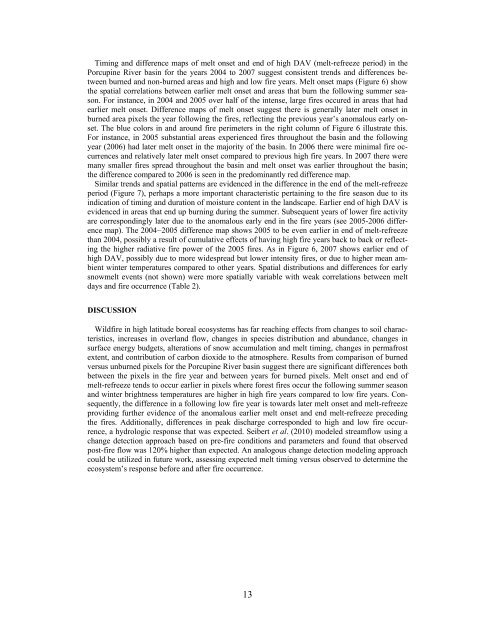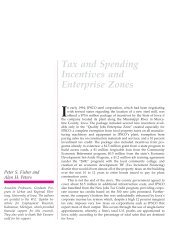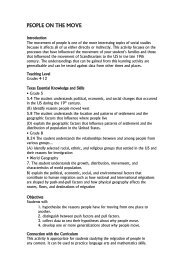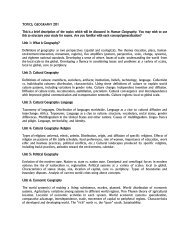Investigating Correlations between Snowmelt and Forest Fires in a ...
Investigating Correlations between Snowmelt and Forest Fires in a ...
Investigating Correlations between Snowmelt and Forest Fires in a ...
Create successful ePaper yourself
Turn your PDF publications into a flip-book with our unique Google optimized e-Paper software.
Tim<strong>in</strong>g <strong>and</strong> difference maps of melt onset <strong>and</strong> end of high DAV (melt-refreeze period) <strong>in</strong> the<br />
Porcup<strong>in</strong>e River bas<strong>in</strong> for the years 2004 to 2007 suggest consistent trends <strong>and</strong> differences <strong>between</strong><br />
burned <strong>and</strong> non-burned areas <strong>and</strong> high <strong>and</strong> low fire years. Melt onset maps (Figure 6) show<br />
the spatial correlations <strong>between</strong> earlier melt onset <strong>and</strong> areas that burn the follow<strong>in</strong>g summer season.<br />
For <strong>in</strong>stance, <strong>in</strong> 2004 <strong>and</strong> 2005 over half of the <strong>in</strong>tense, large fires occured <strong>in</strong> areas that had<br />
earlier melt onset. Difference maps of melt onset suggest there is generally later melt onset <strong>in</strong><br />
burned area pixels the year follow<strong>in</strong>g the fires, reflect<strong>in</strong>g the previous year’s anomalous early onset.<br />
The blue colors <strong>in</strong> <strong>and</strong> around fire perimeters <strong>in</strong> the right column of Figure 6 illustrate this.<br />
For <strong>in</strong>stance, <strong>in</strong> 2005 substantial areas experienced fires throughout the bas<strong>in</strong> <strong>and</strong> the follow<strong>in</strong>g<br />
year (2006) had later melt onset <strong>in</strong> the majority of the bas<strong>in</strong>. In 2006 there were m<strong>in</strong>imal fire occurrences<br />
<strong>and</strong> relatively later melt onset compared to previous high fire years. In 2007 there were<br />
many smaller fires spread throughout the bas<strong>in</strong> <strong>and</strong> melt onset was earlier throughout the bas<strong>in</strong>;<br />
the difference compared to 2006 is seen <strong>in</strong> the predom<strong>in</strong>antly red difference map.<br />
Similar trends <strong>and</strong> spatial patterns are evidenced <strong>in</strong> the difference <strong>in</strong> the end of the melt-refreeze<br />
period (Figure 7), perhaps a more important characteristic perta<strong>in</strong><strong>in</strong>g to the fire season due to its<br />
<strong>in</strong>dication of tim<strong>in</strong>g <strong>and</strong> duration of moisture content <strong>in</strong> the l<strong>and</strong>scape. Earlier end of high DAV is<br />
evidenced <strong>in</strong> areas that end up burn<strong>in</strong>g dur<strong>in</strong>g the summer. Subsequent years of lower fire activity<br />
are correspond<strong>in</strong>gly later due to the anomalous early end <strong>in</strong> the fire years (see 2005-2006 difference<br />
map). The 2004−2005 difference map shows 2005 to be even earlier <strong>in</strong> end of melt-refreeze<br />
than 2004, possibly a result of cumulative effects of hav<strong>in</strong>g high fire years back to back or reflect<strong>in</strong>g<br />
the higher radiative fire power of the 2005 fires. As <strong>in</strong> Figure 6, 2007 shows earlier end of<br />
high DAV, possibly due to more widespread but lower <strong>in</strong>tensity fires, or due to higher mean ambient<br />
w<strong>in</strong>ter temperatures compared to other years. Spatial distributions <strong>and</strong> differences for early<br />
snowmelt events (not shown) were more spatially variable with weak correlations <strong>between</strong> melt<br />
days <strong>and</strong> fire occurrence (Table 2).<br />
DISCUSSION<br />
Wildfire <strong>in</strong> high latitude boreal ecosystems has far reach<strong>in</strong>g effects from changes to soil characteristics,<br />
<strong>in</strong>creases <strong>in</strong> overl<strong>and</strong> flow, changes <strong>in</strong> species distribution <strong>and</strong> abundance, changes <strong>in</strong><br />
surface energy budgets, alterations of snow accumulation <strong>and</strong> melt tim<strong>in</strong>g, changes <strong>in</strong> permafrost<br />
extent, <strong>and</strong> contribution of carbon dioxide to the atmosphere. Results from comparison of burned<br />
versus unburned pixels for the Porcup<strong>in</strong>e River bas<strong>in</strong> suggest there are significant differences both<br />
<strong>between</strong> the pixels <strong>in</strong> the fire year <strong>and</strong> <strong>between</strong> years for burned pixels. Melt onset <strong>and</strong> end of<br />
melt-refreeze tends to occur earlier <strong>in</strong> pixels where forest fires occur the follow<strong>in</strong>g summer season<br />
<strong>and</strong> w<strong>in</strong>ter brightness temperatures are higher <strong>in</strong> high fire years compared to low fire years. Consequently,<br />
the difference <strong>in</strong> a follow<strong>in</strong>g low fire year is towards later melt onset <strong>and</strong> melt-refreeze<br />
provid<strong>in</strong>g further evidence of the anomalous earlier melt onset <strong>and</strong> end melt-refreeze preced<strong>in</strong>g<br />
the fires. Additionally, differences <strong>in</strong> peak discharge corresponded to high <strong>and</strong> low fire occurrence,<br />
a hydrologic response that was expected. Seibert et al. (2010) modeled streamflow us<strong>in</strong>g a<br />
change detection approach based on pre-fire conditions <strong>and</strong> parameters <strong>and</strong> found that observed<br />
post-fire flow was 120% higher than expected. An analogous change detection model<strong>in</strong>g approach<br />
could be utilized <strong>in</strong> future work, assess<strong>in</strong>g expected melt tim<strong>in</strong>g versus observed to determ<strong>in</strong>e the<br />
ecosystem’s response before <strong>and</strong> after fire occurrence.<br />
13
















